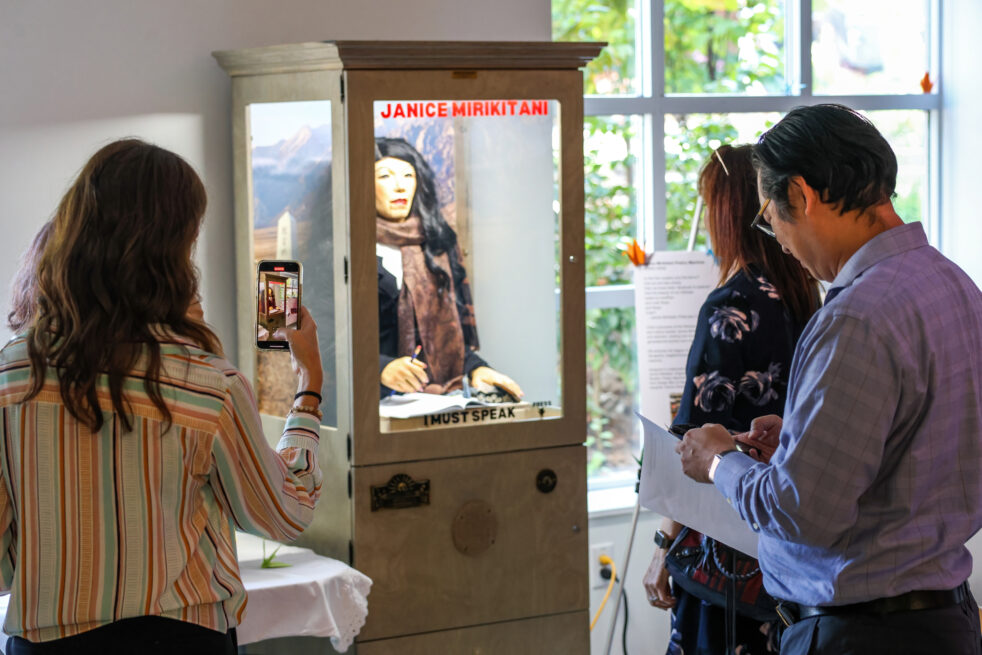Beyond the front doors, the atrium of Ferst Center for the Arts transforms into an interactive exhibit that takes viewers through the experiences of people with Japanese ancestry in the United States after the attack on Pearl Harbor during World War II. Called “Ni Do To,” which translates to “Never Again,” the exhibition is another segment of dancer, choreographer and artistic director Yayoi Kambara’s “Sankei,” a three-part multimedia project that began with the performance of “IKKAI Means Once” at the Ferst Center for the Arts in early September.
“Ni Do To” is a self-described “XR pilgrimage,” XR being short for extended reality. The different areas within the entire installation utilize various storytelling methods, spanning from digital to physical formats.
In one area, singular chairs and desks form a circle around an abstract sculpture made to look like an invisible force is throwing clothing and assorted belongings into a suitcase.
Here, visitors can participate in an activity on iPads where they receive mere minutes to decide what things they would find most important to bring if they had to leave their homes. The exercise intends to simulate how hard it is to determine which parts of your life matter more than others.
Japanese Americans faced the same decisions following the signing of Executive Order 9066 in 1942, which forcefully removed them from their homes, businesses and land.
Several feet away, a recreation of a vintage “Zoltar” fortunetelling machine stands against the wall. However, instead of a vaguely culturally insensitive animatronic inside, “Ni Do To’s” machine is made in memoriam of Janice Mirikitani and contains an old-school animatronic with
her likeness. Mirikitani was a renowned Japanese American poet and activist in San Francisco until her passing in 2021. A year after she was born, she and her family were forcefully moved to the Rohwer War Relocation Center, an internment camp in Arkansas. Instead of dispensing fortunes, the “Ni Do To” machine dispenses Mirikitani’s poetry on textured paper, speaking aloud in what is [presumably, her voice.
In yet another exhibition area, behind black-out fabric walls, is the “Spirit of Obon Hologram.” A video of musician and activist Nobuko Miyamoto invites visitors inside a small open space where they can learn a folk dance called “Kangie” (pronounced “KAHNGee-Eh”) from dancers on a small television screen. Alongside the visitors is a colorful hologram of a dancer projected onto a special kind of gauze.
Integral to the success of the holographic exhibit is Noah Posner, a Tech researcher and lab manager at the School of Industrial Design’s Interactive Product Design Lab (IPDL). Posner offered the IPDL’s resources for the high-tech parts of the show, namely the high-brightness projector that displayed the dancer onto the gauze.
Regarding the use of Tech equipment within the exhibit, Posner believes that the production will show students not only what kind of resources they have access to but also that the blend of technology and arts is reflective of the idea that “the creativity involved with arts-type thinking is really somewhat similar to a lot of the [creativity] required for problem-solving…if [they think] more like artists, [they’d] come up with better engineering solutions.”
The possibilities that come from collaboration between art and technology are often overlooked, but the different parts of “Ni Do To” show the powerful effects that interactive art can have.
Someone who shares that sentiment is professor Ida Yoshinaga, who worked with the students in her “Oral Traditions to Screenplay” class to create origami fortune tellers filled with pictures, quotes and stories of Japanese American incarcerees.
Yoshinaga challenged her students to strengthen the bond between “low tech” and “high tech” mediums by asking “how do you bring culture into technology, or how can you use technology to reproduce culture and communicate the good stuff about culture and community?”
While talking about the importance of “Ni Do To,” Yoshinaga explained that lessons learned from the unjust incarceration of Japanese Americans in the 1940s extend to the marginalized people of today’s day and age.
“When we have vulnerability and people who don’t have full access to political power, economic power and cultural presence, then it’s easy to beat up on them, to target them and make them the issue, as opposed to the deeper, real issues and the structural issues.”
On the same tables as the fortune tellers are paper luggage tags and pens, on which visitors are encouraged to reflect on what they saw and how to prevent it from happening again. These tags get hung up in another art installation.
Also included in the overall experience of the exhibition is the dance film titled “Out of the Dust.”
The short movie combines music, poetry and elements of the Japanese American folk dance “Ei Ja Nai Ka” to conjure the ghosts of those incarcerated at Manzanar Detention Camp in California during World War II to tell their stories through purposeful, emotional expression.
By September 1942, less than one year after President FDR authorized the removal of anyone with Japanese ancestry from their homes to “relocation cen- ters,” Manzanar held over 10,000 men, women and children of Japanese descent; over half were U.S. citizens by birth.
“Out of the Dust” poses the question, “[a]fter the closing of the camps, who and what memories were left behind in the windy dust-laden desert of Manzanar?”
As a whole, the “Ni Do To” exhibit and the “Out of the Dust” film conjure memories and legacies of the thousands of people incarcerated during World War II because of prejudice and fear.
The interactive nature of each element creates an immersive cultural experience for visitors to participate in rather than just observing, resulting in a powerful experience.
“Ni Do To” and “Out of the Dust” are open Tuesday to Saturday at the Ferst Center until October 27.
